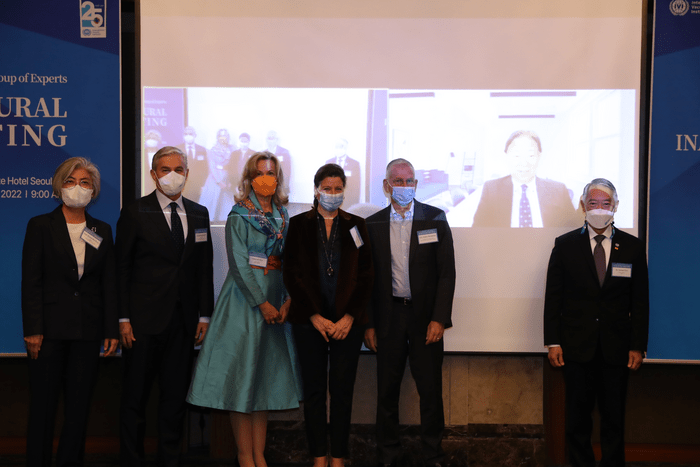October 20, 2022, SEOUL, Republic of Korea — The International Vaccine Institute (IVI), an international organization with a mission to discover, develop, and deliver safe, effective, and affordable vaccines for global health, launched its Global Advisory Group of Experts today during its inaugural meeting held in Seoul, Republic of Korea. Dr. Deborah Birx, former U.S. Special Representative for Global Health Diplomacy and White House Coronavirus Response Coordinator, chairs the GAGE and other members include subject matter experts across international diplomacy, government affairs, international corporations and non-profits, and public policy.
As IVI expands its presence into new regions and research opportunities, the GAGE will guide IVI on matters of global health and diplomacy while facilitating partnerships with key government stakeholders and industry groups. The GAGE, in addition to the Board of Trustees and Scientific Advisory Group, make up IVI’s governance and advisory bodies.
George Bickerstaff, Chairperson of IVI’s Board of Trustees, said: “As a complement to IVI’s Scientific Advisory Group which guides our research teams in producing quality and rigorous scientific outputs, the new GAGE will advise on matters of global health and diplomacy so IVI can play a more dynamic and even more connected role as an international organization and leading product development partner. We are grateful to Dr. Birx and the members of the GAGE for their service, and I am confident that their combined insights and experience will set IVI up for another 25 years of lasting impact.”
Dr. Jerome Kim, Director General of IVI, said: “IVI formed this Global Advisory Group of Experts at a formative juncture in its growth and expansion. With headquarters in Seoul, a new Europe Regional Office in Stockholm and forthcoming Country Office in Vienna, IVI requires strategic guidance on fulfilling its role as a trusted, effective, and sustainable international organization. We look forward to gaining the wisdom and support of our GAGE members as we pursue new partnerships and R&D opportunities in Europe, Africa, and beyond.
Dr. Deborah Birx, Senior Fellow at the Bush Institute and Chairperson of IVI’s GAGE, said: “I am delighted to join and chair IVI’s founding GAGE, gathering international leaders and global health experts to facilitate strategic partnerships and effectively engage governments and other key industry stakeholders as IVI advances in scope and reach. The members of the GAGE look forward to guiding IVI toward its critically important mission to accelerate vaccines for global health.”
IVI’s founding GAGE members:
- Dr. Deborah Birx (Chairperson) is a world-renowned medical expert who spent her first career serving the United States as an Army Colonel and later ran high-profile programs at the U.S. Centers for Disease Control and Prevention and U.S. Department of State. Dr. Birx was the White House Coronavirus Response Coordinator and previously served as U.S. Special Representative for Global Health Diplomacy.
- Dr. Anders Nordström (Vice Chairperson) is the Ambassador for Global Health at the Ministry for Foreign Affairs in Sweden. He is a medical doctor and previously served as the Head of the WHO Country Office in Sierra Leone and as Director-General for the Swedish International Agency for Development Cooperation.
- Dr. Agnès Buzyn is a medical doctor and Professor of Hematology at the Paris-Sorbonne University. She headed the adult hematology intensive care and bone marrow transplants unit at the University Paris Descartes-Necker Hospital and previously held the positions of Minister of Health and Solidarity in France and Executive Director of the WHO Academy.
- Dr. Carla Vizzotti is the Minister of Health of Argentina and specializes in internal medicine and social security and systems. She is a founding member and President of the Argentine Association of Vaccination and Epidemiology.
- Dr. Kyung-wha Kang is a Distinguished Professor Emeritus at Ewha Womans University and served as the 38th and first female Minister of Foreign Affairs of the Republic of Korea. Dr. Kang additionally served as Director-General for International Organizations and Deputy High Commissioner for Human Rights.
- Dr. Samba Sow is a medical doctor and epidemiologist and currently the Director of the Center for Vaccine Development—Mali. He previously served as Mali’s Minister of Health and Public Hygiene and was appointed WHO Special Envoy for COVID-19 in West Africa.
- Dr. Yasuhiro Suzuki is a medical doctor specializing in neurology and led an extensive career in Japan’s Ministry of Health, Labour and Welfare, where he served as Vice-Minister for Health and Chief Medical & Global Health Officer. He is currently the President of the International University of Health and Welfare.
###
About the International Vaccine Institute (IVI)
The International Vaccine Institute (IVI) is a non-profit international organization established in 1997 at the initiative of the United Nations Development Programme with a mission to discover, develop, and deliver safe, effective, and affordable vaccines for global health.
IVI’s current portfolio includes vaccines at all stages of pre-clinical and clinical development for infectious diseases that disproportionately affect low- and middle-income countries, such as cholera, typhoid, chikungunya, shigella, salmonella, schistosomiasis, hepatitis E, HPV, COVID-19, and more. IVI developed the world’s first low-cost oral cholera vaccine, pre-qualified by the World Health Organization (WHO), and developed a new-generation typhoid conjugate vaccine that is currently under assessment for WHO PQ.
IVI is headquartered in Seoul, Republic of Korea with a Europe Regional Office in Sweden and Collaborating Centers in Ghana, Ethiopia, and Madagascar. 39 countries and the WHO are members of IVI, and the governments of the Republic of Korea, Sweden, India, and Finland provide state funding. For more information, please visit https://www.ivi.int.
CONTACT
Aerie Em, Global Communications & Media Specialist
+82 2 881 1386 | aerie.em@ivi.int










































